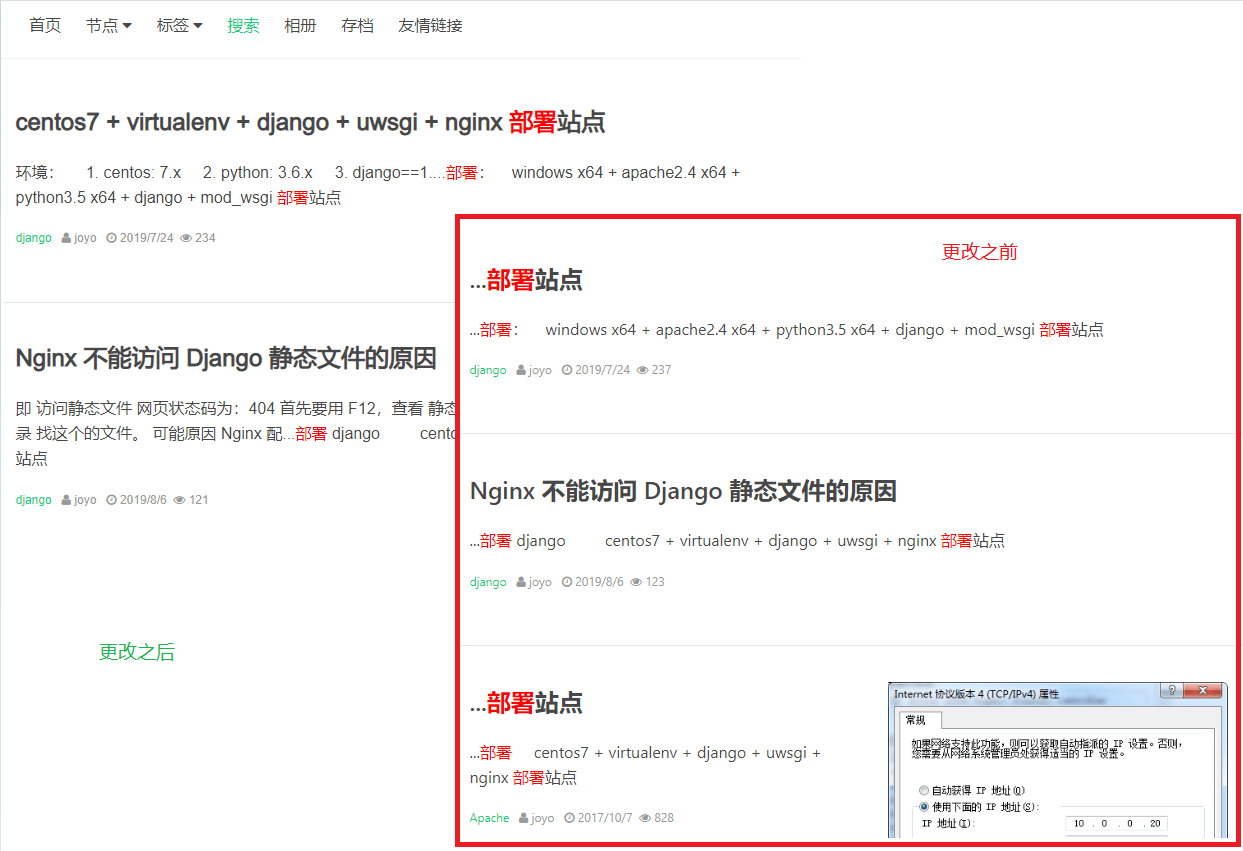django-haystack 让检索结果开头不缩略显示(完全显示)
用 haystack 做检索,检索的关键词前面被缩略显示了即显示 "...",有时候会造成一些麻烦。
自己做了一些改动后,取消了部分缩略显示不合理的地方,效果如下:
如何配置 haystack 检索请看:django-haystack 全文检索
不缩略显示的修改方法
1. 修改 joyoo\blog\templatetags\highlighting.py
# encoding: utf-8
from __future__ import absolute_import, division, print_function, unicode_literals
from django.utils.html import strip_tags
class Highlighter(object):
css_class = 'highlighted'
html_tag = 'span'
max_length = 200
text_block = ''
def __init__(self, query, **kwargs):
self.query = query
if 'max_length' in kwargs:
self.max_length = int(kwargs['max_length'])
if 'html_tag' in kwargs:
self.html_tag = kwargs['html_tag']
if 'css_class' in kwargs:
self.css_class = kwargs['css_class']
self.query_words = set([word.lower() for word in self.query.split() if not word.startswith('-')])
def highlight(self, text_block):
self.text_block = strip_tags(text_block)
highlight_locations = self.find_highlightable_words()
# print(highlight_locations)
# 检索结果不缩略显示 - 此处有修改,增加一个返回值 text_pre
text_pre = ""
for key, values in highlight_locations.items():
# print(key, values)
if values:
if values[0] > 100:
text_pre = self.text_block[0: 100] + "..."
else:
text_pre = self.text_block[0: values[0]]
start_offset, end_offset = self.find_window(highlight_locations)
return self.render_html(highlight_locations, start_offset, end_offset, text_pre)
# return self.render_html(highlight_locations, start_offset, end_offset)
def find_highlightable_words(self):
# Use a set so we only do this once per unique word.
word_positions = {}
# Pre-compute the length.
end_offset = len(self.text_block)
lower_text_block = self.text_block.lower()
for word in self.query_words:
if not word in word_positions:
word_positions[word] = []
start_offset = 0
while start_offset < end_offset:
next_offset = lower_text_block.find(word, start_offset, end_offset)
# If we get a -1 out of find, it wasn't found. Bomb out and
# start the next word.
if next_offset == -1:
break
word_positions[word].append(next_offset)
start_offset = next_offset + len(word)
return word_positions
def find_window(self, highlight_locations):
best_start = 0
best_end = self.max_length
# First, make sure we have words.
if not len(highlight_locations):
return (best_start, best_end)
words_found = []
# Next, make sure we found any words at all.
for word, offset_list in highlight_locations.items():
if len(offset_list):
# Add all of the locations to the list.
words_found.extend(offset_list)
if not len(words_found):
return (best_start, best_end)
if len(words_found) == 1:
return (words_found[0], words_found[0] + self.max_length)
# Sort the list so it's in ascending order.
words_found = sorted(words_found)
# We now have a denormalized list of all positions were a word was
# found. We'll iterate through and find the densest window we can by
# counting the number of found offsets (-1 to fit in the window).
highest_density = 0
if words_found[:-1][0] > self.max_length:
best_start = words_found[:-1][0]
best_end = best_start + self.max_length
for count, start in enumerate(words_found[:-1]):
current_density = 1
for end in words_found[count + 1:]:
if end - start < self.max_length:
current_density += 1
else:
current_density = 0
# Only replace if we have a bigger (not equal density) so we
# give deference to windows earlier in the document.
if current_density > highest_density:
best_start = start
best_end = start + self.max_length
highest_density = current_density
return (best_start, best_end)
def render_html(self, highlight_locations=None, start_offset=None, end_offset=None, text_pre=None):
# def render_html(self, highlight_locations=None, start_offset=None, end_offset=None):
# Start by chopping the block down to the proper window.
text = self.text_block[start_offset:end_offset]
# Invert highlight_locations to a location -> term list
term_list = []
for term, locations in highlight_locations.items():
term_list += [(loc - start_offset, term) for loc in locations]
loc_to_term = sorted(term_list)
# Prepare the highlight template
if self.css_class:
hl_start = '<%s class="%s">' % (self.html_tag, self.css_class)
else:
hl_start = '<%s>' % (self.html_tag)
hl_end = '</%s>' % self.html_tag
# Copy the part from the start of the string to the first match,
# and there replace the match with a highlighted version.
highlighted_chunk = ""
matched_so_far = 0
prev = 0
prev_str = ""
for cur, cur_str in loc_to_term:
# This can be in a different case than cur_str
actual_term = text[cur:cur + len(cur_str)]
# Handle incorrect highlight_locations by first checking for the term
if actual_term.lower() == cur_str:
if cur < prev + len(prev_str):
continue
highlighted_chunk += text[prev + len(prev_str):cur] + hl_start + actual_term + hl_end
prev = cur
prev_str = cur_str
# Keep track of how far we've copied so far, for the last step
matched_so_far = cur + len(actual_term)
# Don't forget the chunk after the last term
highlighted_chunk += text[matched_so_far:]
# 检索结果不缩略显示 - 此处有修改, highlighted_chunk 加上关键词前面的内容
if start_offset > 0:
# highlighted_chunk = '...%s' % highlighted_chunk
highlighted_chunk = '%s%s' % (text_pre, highlighted_chunk)
if end_offset < len(self.text_block):
highlighted_chunk = '%s...' % highlighted_chunk
return highlighted_chunk
2. 在 settings.py 配置 haystack 使用自定义高亮函数:
# Handle a user-defined highlighting function. 处理用户定义的突出显示函数。
HAYSTACK_CUSTOM_HIGHLIGHTER = "blog.templatetags.highlighting.Highlighter"
本作品由 卓越笔记 采用 知识共享署名 - 非商业性使用 - 相同方式共享 4.0 国际许可协议 进行许可
前一篇: django Foreignkey 之 on_delete
下一篇: django runserver: UnicodeDecodeError: 'utf-8' codec can't decode byte 0xb6 in position 0: invalid start byte

